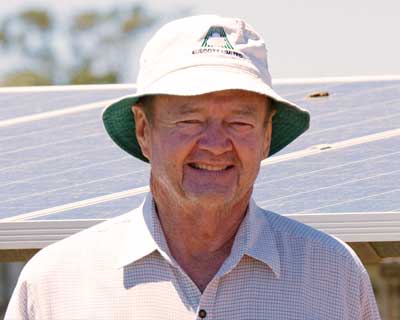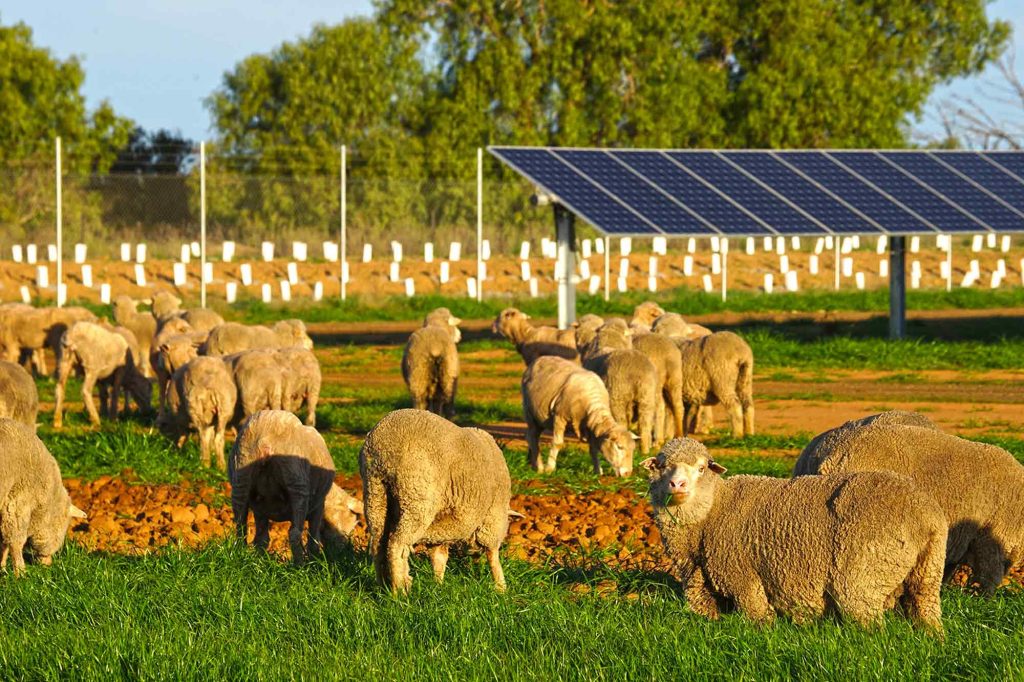About Solar
Dubbo Solar Farm in NSW shows how well agriculture and solar can combine, bringing some unexpected benefits. Neoen are proud to be leading the way in ‘agrisolar’.
A short video about this experience can be found in this video.

There are no issues with sheep-grazing co-existing with solar farms. It’s an opportunity and win-win for farmers and renewable energy producers.
Tom Warren, Land Owner
Dubbo Solar Hub in New South Wales

WHAT IS AGRISOLAR?
Agrisolar is the co-existence of agriculture and solar power generation on the same land.
2017 Parkes Trial
Our first sheep grazing trial was conducted at Parkes Solar Farm in 2017 during a high rainfall and high produce year. It was a joint exercise between Neoen, local landowners and solar construction company Bouygues.
The 3 week trial involved 400 sheep within a 15 hectares zone to help reduce dry grass under the solar panels in order to manage grass fire hazard. It successfully showed that this combined land use had positive outcomes for farmers and solar operators.
2019 Expert Review
By 2019 sheep grazing had begun on all five of our operating solar farms in NSW and Victoria. These activities were assessed by an independent grazier expert to document existing practices and make recommendations on how to integrate grazing into each stage of the solar farm’s lifecycle.
2020 CEC Agrisolar Report
We are leading a collaboration with the Clean Energy Council to bring together research, case studies and lessons from across the industry into a ground-breaking Agrisolar Report. This will help to guide and inform farmers, solar farm operators and government on how best to integrate agriculture and solar.
We are also continuing to explore other opportunities for combined land use including biodiversity and conservation, indigenous crops and carbon farming.
About Solar FAQ's
Neoen uses similar technology to that used in residential solar photovoltaic installations with the main difference being that panels are often mounted on systems that track the sun through the sky. Neoen is experienced in financing, constructing and operating solar farms and in all areas only engages experienced contractors with a proven track record. The Thunderbolt Energy Hub will utilise premium tier 1 quality solar panels and battery technology provided by leading manufacturers.
Neoen’s projects use premium quality panels and inverters provided by leading manufacturers. This is selected through a competitive process for each project. All components come with long warranty periods and performance guarantees.
The construction timeframe depends on the project size and the number of workers deployed on site. For a 100 MW power plant, an 8 to 12-month timeframe is typical, with a peak construction period of 2 to 3 months.
A solar farm will typically operate for between 25 and 30 years. Tier 1 solar panels generally come with a 25-year manufacturer’s warranty. Depending on the local environment, they can generate electricity for 30 years or more with only about 0.5% efficiency loss each year.
Generally speaking solar panels have a dimension of 1m x 2m. Rows of solar panels are usually 30, 60 or 90 meter long. And rows of panels are separated by 5 to 7 meters.
However, this varies from project to project. Wide spacing reduces shadowing on the panels in the early morning and late afternoon, and also allows the land to continue to be used for sheep grazing.
Improved manufacturing techniques on tier 1 panels include anti-reflective (AR) coatings on solar panels. This increases the amount of energy converted by the panels from sunlight. In addition, by minimising reflective losses from (or trapping more light within) solar panels, their performance can be increased while costs are lowered.
Because of these innovations in AR coatings and detailed research solar panel installations are now commonly found in airports around the world where any issue of glare would be highly scrutinised. For example, the Adelaide airport now has 5,000 solar panels with a capacity of 1.28 MW on the roof of the terminal and car park.
We understand that solar arrays do alter the visual character of an area. This is why we work with communities to ensure they have the lowest possible impact on visual amenity.
We encourage individuals and groups with questions about visual impact and solutions to engage with us early.
Overall, we believe that emissions reductions – as well as the immediate and long-term benefits that solar farms bring to communities – offset some loss of visual amenity.
There is very minimal fire risk associated with photovoltaic panels or solar farms.
There is also a cleared vegetation zone around the edges of the solar farms to prevent fire spreading. This is complemented by a strict vegetation management plan.